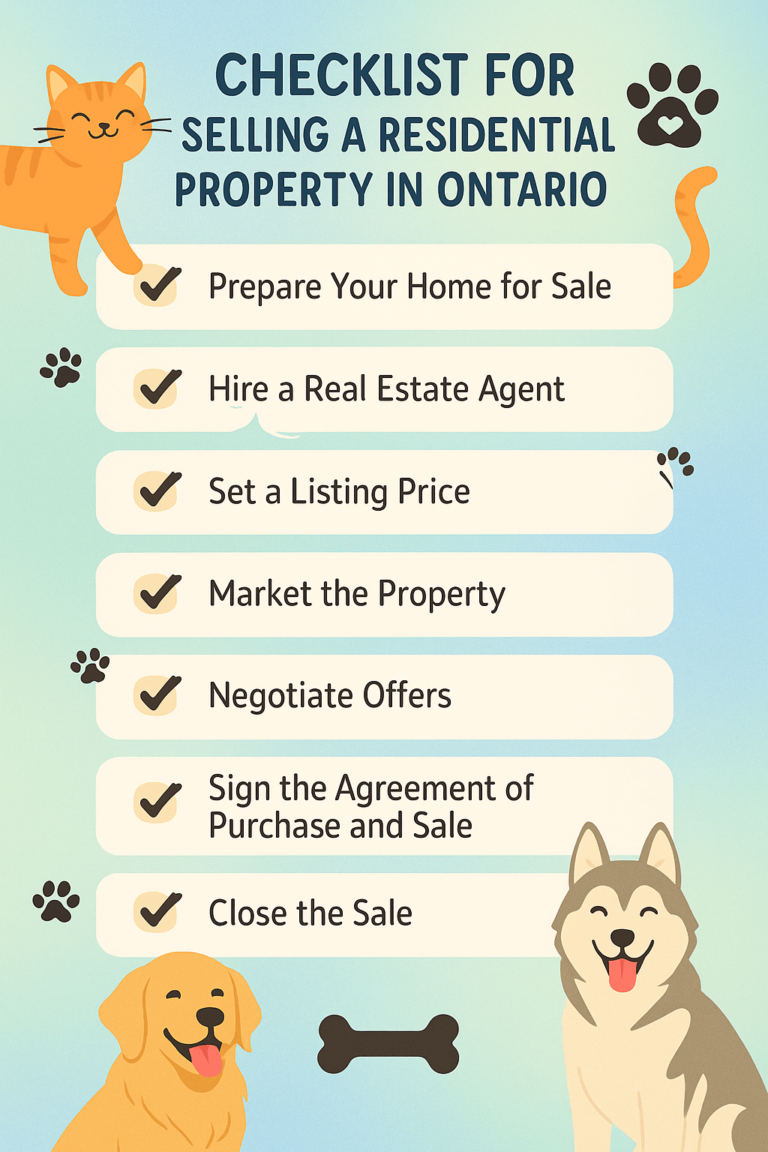Checklist for Selling a Residential Property in Ontario
Selling a home is a significant financial and emotional decision. Whether you’re upsizing, downsizing, relocating, or cashing out an investment, the process involves more than just putting a “For Sale” sign on the lawn. From preparing your home to closing the deal, every step needs to be carefully planned to maximize your profit and minimize stress.
If you’re planning to sell a residential property in Ontario, this comprehensive checklist will help you navigate the process confidently and effectively.
✅ 1. Decide If the Time Is Right
Before you list your home, assess whether now is the best time to sell.
Consider:
Market conditions: Are you in a buyer’s or seller’s market?
Seasonal trends: Spring and early fall are typically ideal times to list.
Personal circumstances: Are you financially and emotionally ready to move?
Tip: Consult a real estate agent or look at recent neighborhood sales (comps) to understand local market dynamics.
✅ 2. Calculate Selling Costs
Selling a home comes with its own set of expenses, and being financially prepared is key.
Costs to expect:
Real estate agent commission: Typically 4%–5% of the sale price, split between buyer and seller agents.
Legal fees: $1,000–$2,500 for a real estate lawyer.
Repairs and staging
Mortgage discharge fees
Moving expenses
Capital gains tax (if it’s not your primary residence)
Pro tip: If selling an investment property, talk to a tax advisor about capital gains implications.
✅ 3. Hire a Real Estate Agent
While selling privately (For Sale By Owner) is an option, most Ontarians benefit from a professional agent’s market expertise.
What to look for:
Proven sales track record in your area
Strong marketing and negotiation skills
Transparent commission structure
Great communication and reviews
Your agent will help you price, market, and negotiate the best possible outcome.
✅ 4. Determine Your Home’s Value
Accurate pricing is crucial. Too high and you scare off buyers; too low and you leave money on the table.
Methods:
Comparative Market Analysis (CMA): Your agent will compare similar homes recently sold in your area.
Professional appraisal: Optional, but helpful for unique properties.
Tip: Pricing competitively increases your chances of a quicker sale and multiple offers.
✅ 5. Make Repairs and Improvements
First impressions matter. Tackle repairs that may raise red flags for buyers or home inspectors.
Focus on:
Leaky faucets and plumbing issues
Damaged walls or floors
Windows and doors that don’t close properly
Outdated light fixtures
Landscaping and curb appeal
Don’t over-renovate: Stick to improvements with high ROI like fresh paint, lighting upgrades, and small kitchen or bathroom updates.
✅ 6. Declutter, Clean, and Stage
A clean, bright, and uncluttered home allows buyers to imagine themselves living there.
Checklist:
Declutter closets, counters, and surfaces
Deep clean every room (consider hiring pros)
Remove personal items like family photos
Neutralize colors and decor
Let in natural light
Stage rooms to highlight space and function
Pro tip: Home staging can increase offers and reduce time on market. Some agents include this as part of their service.
✅ 7. Gather Key Documents
Having paperwork ready can speed up the sales process and reassure buyers.
Common documents:
Property tax bills
Utility bills
Survey of property
Deed/title
Maintenance and renovation records
Applicable warranties (roof, appliances, HVAC)
Condo status certificate (for condo sellers)
✅ 8. Market Your Home
A successful sale depends on strong marketing that reaches the right buyers.
Effective strategies:
MLS listing: The primary platform for agents and buyers
Professional photos and videos
Virtual tours or 3D walkthroughs
Open houses (virtual and in-person)
Social media marketing
Targeted ads (Google, Facebook, etc.)
Your agent should coordinate all of this and create a tailored marketing plan for your home.
✅ 9. List Your Home
Once your home is prepped and photographed, it’s time to officially go live.
Listing includes:
High-quality photos
Compelling property description
Accurate details (square footage, lot size, age)
Highlighting unique features (finished basement, new roof, location perks)
Tip: Make your home available for showings with flexible viewing times, including evenings and weekends.
✅ 10. Review Offers and Negotiate
If your home is priced right and marketed well, offers should come in quickly.
When reviewing offers:
Look beyond price: consider closing dates, conditions (financing, inspection), and deposit amount.
Compare multiple offers if you’re lucky enough to get them.
Your agent will guide you in negotiating counter-offers and selecting the best deal.
Common conditions: Financing, home inspection, sale of buyer’s current home.
✅ 11. Accept an Offer
Once you accept an offer, the buyer typically has a few days to satisfy any conditions.
Your responsibilities:
Take the home off the market
Cooperate with buyer’s home inspector or appraiser
Begin preparing for your move
Note: The sale isn’t “firm” until all conditions are waived or fulfilled.
✅ 12. Hire a Real Estate Lawyer
An Ontario real estate lawyer is essential to complete the sale.
Your lawyer will:
Review the Agreement of Purchase and Sale
Handle closing day logistics
Discharge your mortgage
Transfer title and funds
Ensure property taxes and utility payments are up to date
Tip: Choose a lawyer experienced with Ontario real estate law, ideally one recommended by your agent or past clients.
✅ 13. Prepare for Closing Day
Closing is the final step when ownership is transferred and you receive your sale proceeds.
What to do:
Cancel utilities and insurance (after closing)
Provide your lawyer with a void cheque for fund transfers
Clean the home and remove all belongings
Leave behind keys, garage openers, warranties, and manuals
Pro tip: Take a final walk-through to ensure the property is left in agreed-upon condition.
✅ 14. Move Out
Whether you’re heading to a new home or temporary housing, organize your move carefully.
Tips:
Book movers early, especially during busy months
Label boxes and pack an essentials bag
Notify service providers of address change
Redirect your mail via Canada Post
Don’t forget: Provide your lawyer and agent with your new contact information.
✅ 15. Keep Records and Settle Final Bills
After closing, make sure you retain important documents and settle any loose ends.
Final tasks:
Save the closing statement, final utility bills, and lawyer correspondence
Pay any outstanding property tax adjustments
Notify your bank, employer, and government agencies of your address change
Bonus: Consider meeting with your accountant to review the sale for any tax obligations or deductions.
Final Thoughts
Selling your residential property in Ontario may seem overwhelming at first, but with proper planning and a strong support team, it can be a smooth and rewarding process. This checklist helps you stay organized, focused, and proactive through each phase — from decision-making to closing.
A well-prepared seller not only gets a better price but also has peace of mind knowing everything was handled correctly.




